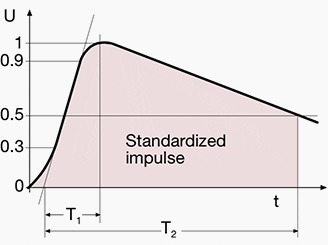
Impulse withstand voltage test performed on assemblies (on photo: Tests in the impulse current laboratory by DEHN)
Rated impulse withstand voltage
Only optional in the past, the impulse test which allow defining the rated impulse withstand voltage Uimp, is now a necessity thus demonstrating the strategy of the Standards directed to increasing the importance of such performance.
In addition to the ordinary temporary overvoltages, usually incoming from the supply line, the plants and the relevant assemblies are prospective victims of peaks and transient not-linear overvoltages due to atmospheric causes (fulminations) both direct, when they affect materially the structure, as well as indirect, when their effect is generated by the electromagnetic fields induced around the impact point of the lightning.
The test requires the application of the impulse withstand voltage 1.2/50 μs (see Figure 1) in compliance with a particular procedure.

Figure 1 – Application of the impulse withstand
The impulse voltage shall be applied five times at intervals of 1 second minimum between:
- All the circuits connected together and the enclosure connected to earth
- Each pole, the other poles and the earthed enclosure connected together.
The present tendency, which is evident in the Tables of the IEC 61439-1, enhances some round figures such as six, eight, ten and twelve kV.
The direct test is performed according to a specific table (Table 10 of the IEC 61439-1, shown below) which suggests the alternative between effective impulse, alternating voltage (r.m.s. value) and direct voltage, with the value defined as a function of the altitude and consequently of the quality of the ambient air around the assembly under test.
The test is passed if no discharges are detected.

Table 1 – IEC 61439-1, Impulse withstand voltages
The verification by design rule (in alternative to test) shall confirm that the clearances between all the live parts and the parts subject to the risk of discharge are at least 1.5 times the values specified in Table 1 of the IEC 61439-1 shown hereunder.
The safety factor 1.5 takes into consideration manufacturing tolerances.

Table 2 – Safety factor (minimum clearance in air)
The minimum clearances shall be verified by measurement or verification of measurements on design drawings.

Figure 3 – Clearances in air
It is evident that to guarantee that the whole assembly has a determined Uimp, in addition to the test or to the design rule verification which confirm this characteristic, also each component installed inside the assembly shall have an equal or higher Uimp value.
For example, the ABB’s ArTu system guarantees both 50 Hz dielectric withstand as well as impulse voltage withstand. In particular versions L and M have:
- Un = 690 V
- Ui = 1000 V
- Uimp = 6 kV wall-mounted and 8 kV floor-mounted
and version K has:
- Un and Ui = 1000 V * Uimp = 8 kV
Reference: Technical Application Papers No.11 – Guidelines to the construction of a low-voltage assembly complying with the Standards IEC 61439 Part 1 and Part 2